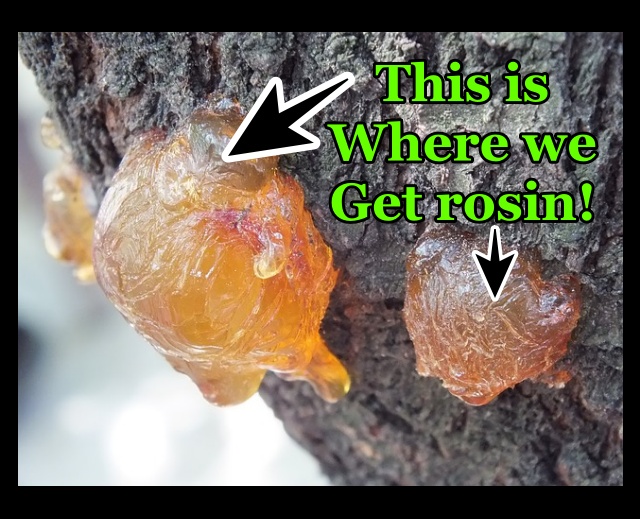Q: Do you need rosin to play the violin?
A: Yes, you do! Without rosin, plain bow hair would make next to no sound when drawn across the violin strings.
Bow hair by itself does not produce enough friction to cause the strings to vibrate.
Q: How do I rosin a bow?
A: Hold your bow in your bowing hand. Hold your rosin in your fingering hand.
Pretend your rosin is your violin string and draw the bow across the rosin as if you were playing your violin.
Make sure to use medium draw pressure; not too light, not too heavy.
Draw the bow across the rosin and make enough swipes to produce a white coating of rosin on your bow hair.
However, you can overdo it. When you stop just after you see the bow hair get powdery with rosin.
Q: How do you make violin rosin?

A: Though every rosin maker has their own methods, it all begins with collecting the pine resin from pine trees.
Sort of like tapping a maple tree for maple syrup.
This resin is then put through a process of heating and straining that purifies it.
After this, the rosin can be cooled into a cake form that violinists see.
Sometimes rosin makers will include additives such as gold, tin, and silver that can change the sonic qualities of the rosin.
Q: How long does violin rosin last?
A: This question has several answers. Technically speaking, violin rosin has a relatively long shelf life as most rosins do not carry an expiration date.
However, I personally find that most rosins begin deteriorating into a more brittle form of itself within the 2 to 4-year mark.
With that said, there are other considerations such as your area’s heat and humidity and the rosin’s exposure to such elements.
For example, if left to sit in the hot sun too long and the rosin is soft enough, it will actually begin to melt.
This rosin can be fully melted and reformed for reuse, but I find that for learning violinists, this process is simply not efficient, and it is better to buy new rosin.
If I have not personally used up a rosin within 2 years of purchase, I typically buy a new one.
This shows us that the life-span of rosin definitely makes it worth investing a little more money for a quality product.
Many players replace their rosin every year, regardless of whether or not it was fully used.
Q: How long does violin rosin last on your bow while playing?

A: The answer to this question largely depends on how much playing you do.
If you play often and for long periods of time, your rosin will be used up quicker.
High-quality rosins tend to produce friction for longer periods of time, but at the end of the day, how much you play will have a direct relationship on the how long your rosin is effective after rosining your bow.
Q: How often should I rosin my bow?
A: For me, rosining up my bow gets me 2-4 hours of practice time.
That ends up being at least one new rosining of the bow per day.
However, your mileage may vary depending on the quality of your rosin, the environment in which you live, how aggressive a player you are and the style of music you play.
Use my example as a general guideline knowing that your experience will involve your individual factors.
Eventually you will be able feel when your bow is losing friction and needs more rosin.
Q: How much does violin rosin cost?
A: Violin rosin can cost anywhere from $2 to $200 (depending on your preferences, the rosin’s availability, and its quality).
Once you get past the $14-16 mark, you are entering the premium rosin realm.
Generally speaking, the more money you spend on rosin, the higher the quality.
However, since violins and rosin are such unique objects and have true personalities, rosin choice can be a deeply particular decision.
There is absolutely a point of diminishing returns.
No beginning student should pay higher prices on rosin, but simultaneously, they shouldn’t spend as little as possible and receive an inferior product.
Anywhere from $6-$15 is optimal for a beginner to intermediate student while advanced students and professionals will likely be spending $15 and up, depending on their tastes.
Q: How much rosin should I put on my violin bow?
A: Jumping off from an earlier question, we want enough rosin on the bow to be visible, but more importantly, to provide enough friction to make the strings vibrate.
This usually means anywhere from 3-6 full draws of the bow across your rosin cake.
Unless you are priming your bow, more than 6 draws will likely produce an excessive amount of rosin dust (especially with low-quality rosins).
However, I will give potentially harder rosins a few additional draws if necessary as they may not allow as much rosin to be applied to the bow hairs as a softer, stickier rosins.
Final Thoughts
I hope this helped to answer some of those burning questions.
Rosin isn’t a terribly complicated topic, but there are can be a lot of mystery surrounding it when we first start playing the violin.
Please feel free to check in with me on social media if you have any more questions. Thanks for reading!





